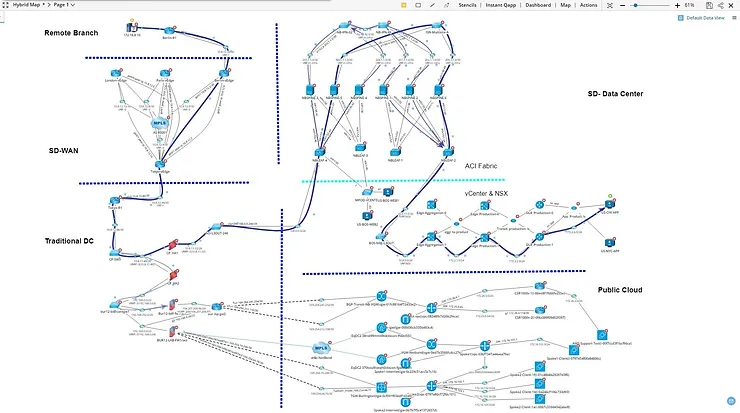Mastering Asset Discovery: The Foundation of IT Infrastructure Management

Asset management is a foundational step that ensures organizations have a comprehensive understanding of their IT assets, setting the stage for efficient operations, optimal performance, and informed decision-making.
Not surprisingly, 64% of organizations lack the foundational visibility and inventory of their hardware, software, virtual and cloud assets.
Many organizations have variety of tools that serve legitimate specialized needs, but they also create data and process silos that impact your ability to get enterprise-wide visibility and control of your technology assets without resource-intensive, manual processes.
Most organization start their Asset management journey with discovery, and there are two primary asset discovery techniques – Auto-discovery and physical audit discovery. While we understand that everyone wants to be able to auto-discovery their environment and that there are advantages to auto-discovery. The real value lies in the synergistic benefits when both auto and physical are combined.
Auto-Discovery: Unveiling the Digital Landscape
Automation is a cornerstone in modern IT operations, revolutionizing how organizations manage and optimize their infrastructure. Auto-discovery is one of the easiest ways to introduce automation into your environment, and a critical one at that in a world of BYOD and remote work.
Advantages of Auto-Discovery:
-
Efficiency: Automated tools swiftly scan networks, identifying devices, applications, and services without manual intervention.
-
Real-Time Updates: Continuous monitoring ensures that the asset inventory remains up to date, reflecting changes in the dynamic IT environment.
-
Accuracy: Automation reduces the risk of human error, providing a more accurate and reliable asset inventory.
But auto-discovery is not without its own challenges:
-
Incomplete or way too much data: Auto-discovery tools may not always provide a complete picture of the IT environment. Some devices or applications may go undetected, leading to gaps in the asset inventory. This can result from network segmentation, firewalls, or devices with low discoverability. The flip side of incomplete data is too much data. Scanning an entire network will typically lead you to a plate of spaghetti that is impossible to sort through.
-
False negatives and positives: Auto-discovery processes can generate false positives (incorrectly identifying non-existent assets) or false negatives (failing to detect existing assets).
-
Lack of Context: In a world that is mostly virtual, there are still data center and the physical infrastructure that are inside. The physical layer cannot be fully auto discovered.
-
Old Technology: Most auto-discovery is still based on SNMP, which has been around for a very long time. While a proven and simple solution, it takes maintenance to work keep SNMP active and secured. Otherwise, you are in an Agent model, which no one likes.
To mitigate these downsides, organizations often complement auto-discovery with other asset management strategies, such as periodic physical audits, manual verification, and a combination of different discovery techniques.
Physical Audit Discovery: Touching the Tangible
Advantages of Physical Audit Discovery:
Physical audits play a crucial role in enhancing the accuracy, security, and overall effectiveness of IT asset management. By physically verifying the existence and condition of assets, organizations gain the following key benefits:
-
Verification and Accuracy: Physical audits provide tangible confirmation of the presence and state of assets, ensuring that the digital records align with the physical reality. This verification significantly enhances the accuracy of the asset inventory.
-
Security Assurance: Physical audits contribute to identifying and addressing security vulnerabilities associated with physical devices. This proactive approach helps organizations bolster their overall security posture by ensuring that physical assets are secure and accounted for.
-
Lifecycle Management: Understanding the physical state of assets aids in planning for upgrades, replacements, and overall lifecycle management. This knowledge ensures that organizations can strategically allocate resources and make informed decisions about the maintenance or retirement of assets.
The challenges of physical audits are usually boiled down into one primary issue:
-
TIME: Yes, it is time consuming to manually check and validate each asset or trace every physical cable that is connected. On top of the fact that no one likes doing that work.
The Power of Integration: Synergistic Benefits
While each technique offers distinct advantages, the true power lies in combining them for a holistic asset discovery strategy.
Benefits of Combining Auto-Discovery and Physical Audit Discovery:
-
Enhanced Accuracy: Auto-discovery lays the digital groundwork, and physical audits validate and refine this information, ensuring a high level of accuracy.
-
Comprehensive Visibility: The combination provides a 360-degree view, covering both digital and physical aspects of assets, leaving no room for blind spots.
-
Risk Mitigation: By cross-verifying digital data with physical audits, organizations can identify discrepancies, mitigate risks associated with inaccurate information, and enhance overall security.
Mastering asset discovery is pivotal for effective IT infrastructure management and on-going Asset Management. By harnessing the strengths of both auto-discovery and physical audit discovery, organizations can build a robust foundation, ensuring accuracy, security, and enterprise visibility.
Stay tuned for our next blog post as we explore the next crucial pillar of end-to-end visibility: Navigating the Complex Web: Strategies for Effective Asset Mappin

